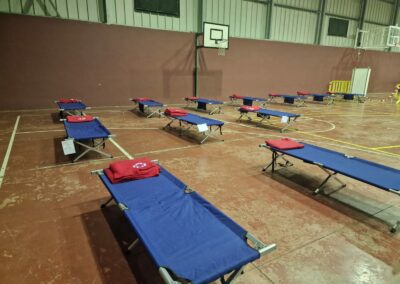As of this Saturday August 19, 2023, the wildfire on Tenerife remains “challenging” and the situation has escalated significantly. The fire, which has been raging since Tuesday night and the early hours of Wednesday morning, has now led to the potential evacuation of approximately 26,000 people, a stark increase from the 5,000 initially reported. The meteorological conditions have been described as “severe,” particularly during the early hours of Saturday. These adverse conditions, including shifting winds and low humidity, are primarily affecting the northern front of the fire. Meanwhile, on Gran Canaria, rain showers have surprised most areas of the island where warnings of a heatwave had be voiced previously throughout the day.
President Fernando Clavijo of the Canary Islands Government has acknowledged the difficulties posed on Tenerife by the massive column of smoke and unpredictable winds. These factors, coupled with other meteorological aspects like high temperatures and low humidity, have been hindering the firefighting efforts. Smoke is proving to be a major obstacle for aerial firefighting operations, which could jeopardise the safety of these vital resources.
 During a press conference held this Saturday, President Clavijo emphasised that the situation has become more complicated due to the changing weather conditions. He specifically mentioned that the northern front of the fire is presenting the greatest challenges, impacting municipalities including La Matanza de Acentejo, La Victoria de Acentejo, Santa Úrsula, La Orotava, and Los Realejos. This area has experienced erratic winds, low humidity, and high temperatures, contributing to the fire’s expansion.
During a press conference held this Saturday, President Clavijo emphasised that the situation has become more complicated due to the changing weather conditions. He specifically mentioned that the northern front of the fire is presenting the greatest challenges, impacting municipalities including La Matanza de Acentejo, La Victoria de Acentejo, Santa Úrsula, La Orotava, and Los Realejos. This area has experienced erratic winds, low humidity, and high temperatures, contributing to the fire’s expansion.
President Clavijo said that technicians had characterised the fire as “hungry” and highlighted the extraordinary efforts of the various firefighting teams. He noted that despite the difficulties, the situation has not reached the worst-case scenario thanks to the collective efforts of firefighting personnel.
 To address the escalating situation, additional resources are being deployed. Two more forest brigades are being sent, and another two hydroplanes are expected to arrive on the island today. These hydroplanes are anticipated to become operational on Sunday, aiding in the continuing firefighting efforts.
To address the escalating situation, additional resources are being deployed. Two more forest brigades are being sent, and another two hydroplanes are expected to arrive on the island today. These hydroplanes are anticipated to become operational on Sunday, aiding in the continuing firefighting efforts.
The Government of Canarias released an update at 4:00 PM this Saturday, stating that the number of potential evacuees has risen to 26,000, a substantial increase from the previous count of nearly 5,000. The fire’s impact has led to a larger displacement of residents from their homes, reflecting the severity of expectations for the ongoing situation.
Overall, the wildfire on Tenerife continues to pose significant challenges, particularly on the northern front where weather conditions are exacerbating the firefighting efforts. Despite the difficulties, the collaborative work of firefighting teams and the deployment of additional resources are aimed at managing and eventually containing the fire.
The fire has already consumed an area of 6,791 hectares, affecting a perimeter of 62 kilometres. The number of evacuees has risen to 26,000, and it is expected to increase further in the coming hours. This is due to the decision to evacuate several residential areas in Tacoronte as one of the fire fronts has been reactivated. Additional evacuations are also possible throughout the night.
 Sudden showers on Gran Canaria
Sudden showers on Gran Canaria
A distant glimmer of hope. Just 40km away, in an unexpected turn to the weather, the neighbouring island of Gran Canaria have this afternoon be experiencing squalls coming in off the Atlantic, bringing intermittent showers to the north east of the island, and the potential for occasional storm weather. Only this morning the island was being put on alert for a return to very high temperatures, expected to exceed 37ºC in the shade.
With any luck some of the wet weather we are seeing here will make its way over towards Tenerife and help to improve the situation on the ground.


























